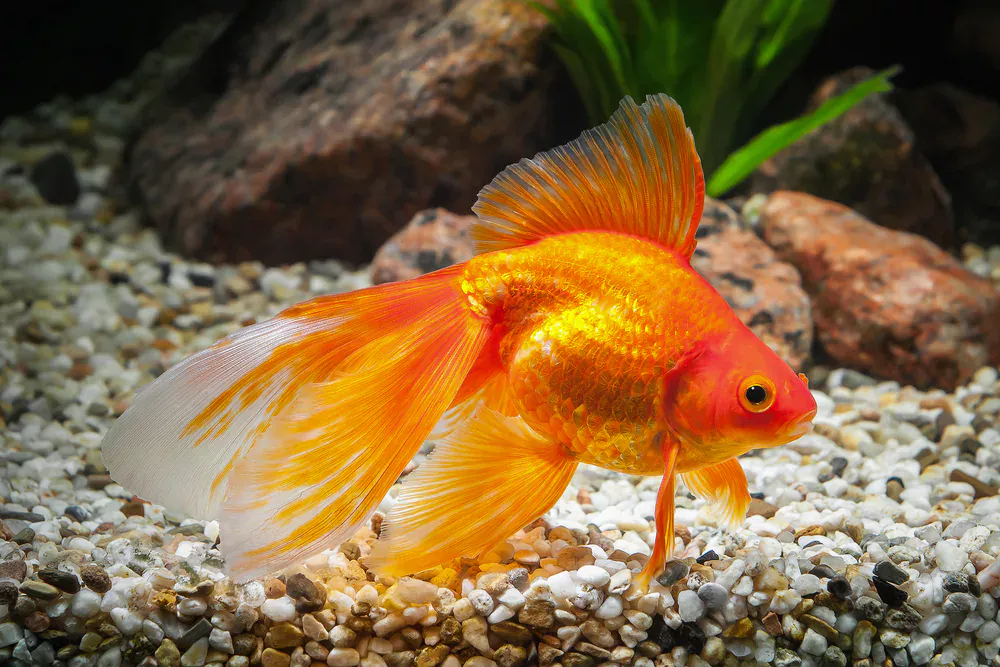Fan Tailed Goldfish; if you are among those who are seriously interested in fish, then no doubt you must have heard of these fancy goldfish. These are quite a popular aquarium fish in almost every place on earth with water bodies and a nation to match. There is a lot to learn about Fan Tailed Goldfish.
So let’s start with the most basic question:
- 1 What Do Fan Tailed Goldfish Look Like?
- 2 What Color Are Fan Tailed Goldfish?
- 3 Fantail Goldfish Size
- 4 How Much Do Fan Tailed Goldfish Cost?
- 5 Fantail Goldfish Care
- 6 Fan Tailed Goldfish Potential Diseases
- 7 Benefits Of Owning A Fantail Goldfish?
- 8 Downsides Of Owning A Fantail Goldfish?
- 9 Final Thoughts
What Do Fan Tailed Goldfish Look Like?
Fantail Goldfish is one of the most popular varieties of fancy goldfish. They have long bodies and tails that look like fans. Their fins are long, thin, and pointed at the ends. The tail is usually longer than the body.
Fantail Goldfish’s body is deep (compared to other types of fancy goldfish) with a wide, flat head that is almost as long as its body. The eyes are set high on the head so they look straight ahead instead of down like some other types of goldfish do. The gill covers extend beyond the eyes so they seem larger than normal for this type of fish.
Fantail Goldfish has an egg-shaped body with a large hump behind their heads where their dorsal fin starts (on top). Their backs curve downward from this hump to their tails which curve upward at the end instead of being straight like other types of fancy goldfish have them.
What Color Are Fan Tailed Goldfish?
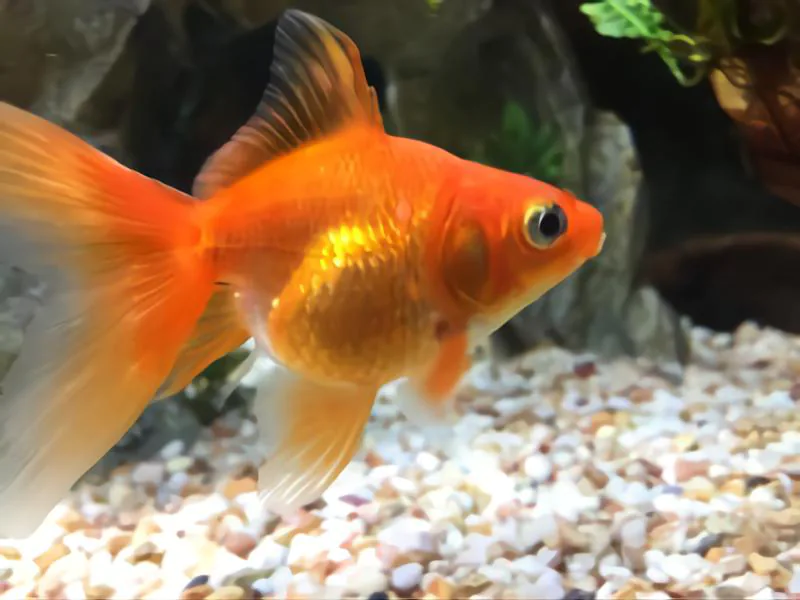
The most common color is orange, but there are many other color varieties available in this breed. Some of these include blue, silver, black, bronze, red, and calico.
The tail can be any color except white or black. The body color can also be any shade of yellow or orange with dark markings on the sides of the fish’s body and fins. These markings may resemble scales or spots, they vary depending on whether your fish is male or female (males often have more distinct markings).
Fantail Goldfish Size
The adult fantail goldfish can reach up to 8-12 inches in length. The male fan tailed goldfish will have longer fins than the female pet fan tailed goldfish because they have more testosterone than the females do.
How Much Do Fan Tailed Goldfish Cost?
The average price for fantail goldfish depends on the size, and type you want. For example, if you want a fancy variety with long fins, your price will be higher than if you just want an ordinary colored fantail and don’t mind if its fins are short or long.
The cost of a fantail goldfish also depends on where you live and what color you want. For example, if you live in the United States or Canada, you’ll probably pay between $5 – $15 for your fish. If you live in Europe or Asia, this price range would be slightly higher because shipping costs would be added to the price tag unless you find them in a local pet store. On average a Fantail goldfish costs between $5 – $40.
Fantail Goldfish Care
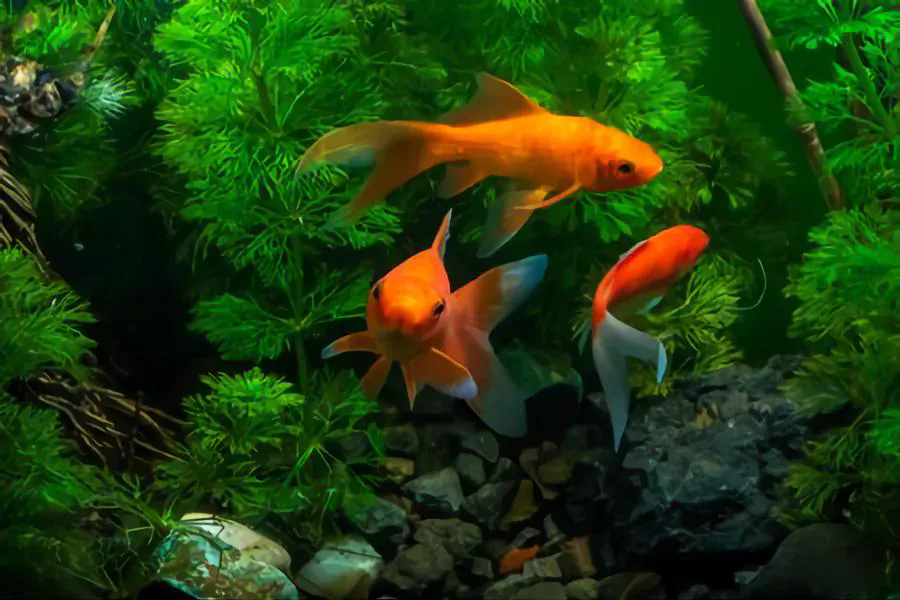
As you know fantail goldfish is one of the most popular breeds of fancy goldfish. They’re active, energetic fish that can be kept in both freshwater and saltwater environments. When you first get your fantail goldfish, you’ll want to make sure they are healthy and happy.
While they’re fairly hardy, there are some things to consider when keeping them as pets.
Here are some things to keep in mind before you buy fantail goldfish:
Fantail Goldfish Tank Size
A 10-gallon or larger tank is best for one or two small fantails. You can keep more in a larger tank, but the smaller tanks are easier to maintain.
Fan Tailed Goldfish Water Parameters
- pH level: 6.0-7.5
- Temperature: 60-80 degrees Fahrenheit
- CO2: Recommended but not necessary
- Oxygen: Recommended but not necessary
Although fantail goldfish are very hardy fish and can live in a wide range of water conditions, from soft to hard, acidic to alkaline, and warm to cool. However, it is important to keep in mind that you should always try to match the temperature of the tank with the temperature of your home to avoid sudden temperature changes that could stress out your fancy goldfish.
The ideal pH level for fantail goldfish is 6.0-7.5, which will give them a healthy growth rate and prevent any health issues from developing due to an acidic or alkaline environment in their tank. While they can tolerate some fluctuation in their pH levels, long-term exposure to either extreme may cause problems with their gills, which can lead to death if left untreated.
What To Put In Fan Tailed Goldfish Tank?
Here are some things that should be added to the fantail goldfish tank:
1- Substrate
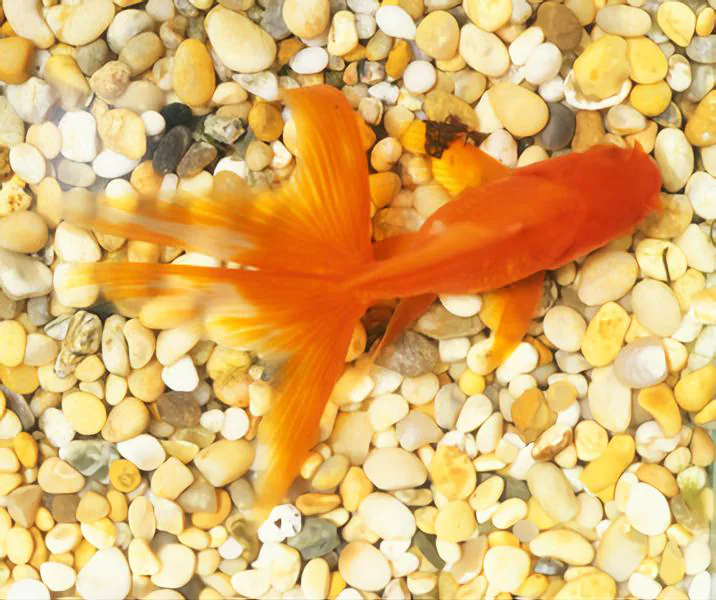
Sand is the most common substrate used in a fantail goldfish tank because it is easy to clean up after messes made by your fantails and other pets in the house! Sand is also very affordable so if you don’t want to spend too much on bedding then this is a good choice for you!
2- Live Plants
Fantails like having live plants around them because these plants give them something to hide behind when they feel threatened by larger fish or humans alike! Live plants also help keep your water clean by absorbing nitrates from your water before they become toxic for your fish friends.
3- Rocks
Rocks add another dimension to any fish tank because they allow your fish friends to hide under them or around them if they want to. You can use real rocks or artificial ones but make sure that they won’t damage the glass of your tank or cause any harm to your fish friends.
4- Fluorescent Lighting
Fluorescent lighting is great for tanks because not only does it save energy but it also keeps your tank looking bright and healthy. You can use this type of lighting for all kinds of fish tanks but make sure that it doesn’t create too much heat which could kill off some of your tiny little fish.
Fan Tailed Goldfish Behavior & Temperament
The behavior of a fantail goldfish depends on how you raise them when they are young. If you raise your fish in a fish tank with other fish then they will tend to be more social than if you keep them by themselves from an early age. Fantails that have been raised by themselves tend to be more aggressive towards other fish than those who have been raised together with other fish from an early age.
Fantail goldfish can be quite aggressive towards humans if they feel threatened or scared by something that has happened. If they feel threatened by something, they will nip at whatever is causing them to feel this way. In some cases, this can lead to them biting people or other animals. However, if you handle your fish gently and carefully, you should never have any issues with them biting you or anyone else in your home.
Fan Tailed Goldfish Food & Diet
To keep your fish healthy, feed them a variety of different foods that contain both plant and animal matter. This will supply them with the nutrients they need to grow strong and healthy. It’s important not to overfeed your fish, as this can cause them to become overweight which can lead to health problems.
Fantail goldfish are omnivores, that means they eat both meat and plants. They will eat almost anything, but you should feed them a balanced diet to ensure they stay healthy and happy.
Live foods such as bloodworms can be fed to your fantail goldfish once every week or two for best results. This type of food is high in protein, which will help keep your fish’s skin healthy and shiny. Bloodworms are usually sold in tanks at pet stores or online. On the other days of the week, give them regular fish food such as flakes or pellets instead.
You can also feed your fantail goldfish live brine shrimp or mosquito larvae if you don’t want to use bloodworms regularly. Brine shrimp is extremely nutritious for your fish, but it does not contain any nutrients that can harm your fish if eaten too often (such as iodine). Mosquito larvae contain more fat than bloodworms do which makes them less nutritious; however, they’re still good for feeding.
Fan Tailed Goldfish Tank Mates
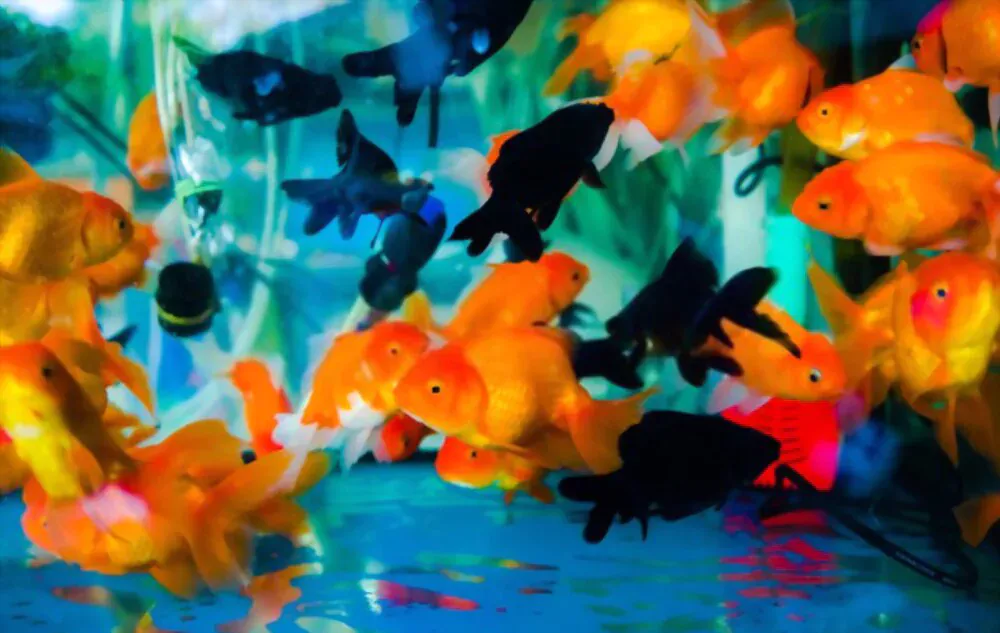
Fantail goldfish are generally peaceful, so they make great tank mates for most other types of fish. However, there are some species that should not be kept with fantails due to their aggressive behavior or because they may be too large for the size of your tank.
If you are looking for great tank mates for your fantails, here is our list of the best fantail goldfish tank mates:
- Ryukin Celestial Eye Goldfish
- Bubble Eye Goldfish
- Cory Catfish
- Rosy Barbs
- White Cloud Mountain Minnows
- Angelfish
- Molly Fish
- Dwarf Gouramis
- Zebra Danio
- Spotted Puffer Fish
- Telescope Goldfish
- Kuhli Loaches
- Neon Tetras
- Otocinclus
- Cherry Shrimp
- Amano Shrimp
- Ghost Shrimp
Is My Fan Tailed Goldfish Male or Female?
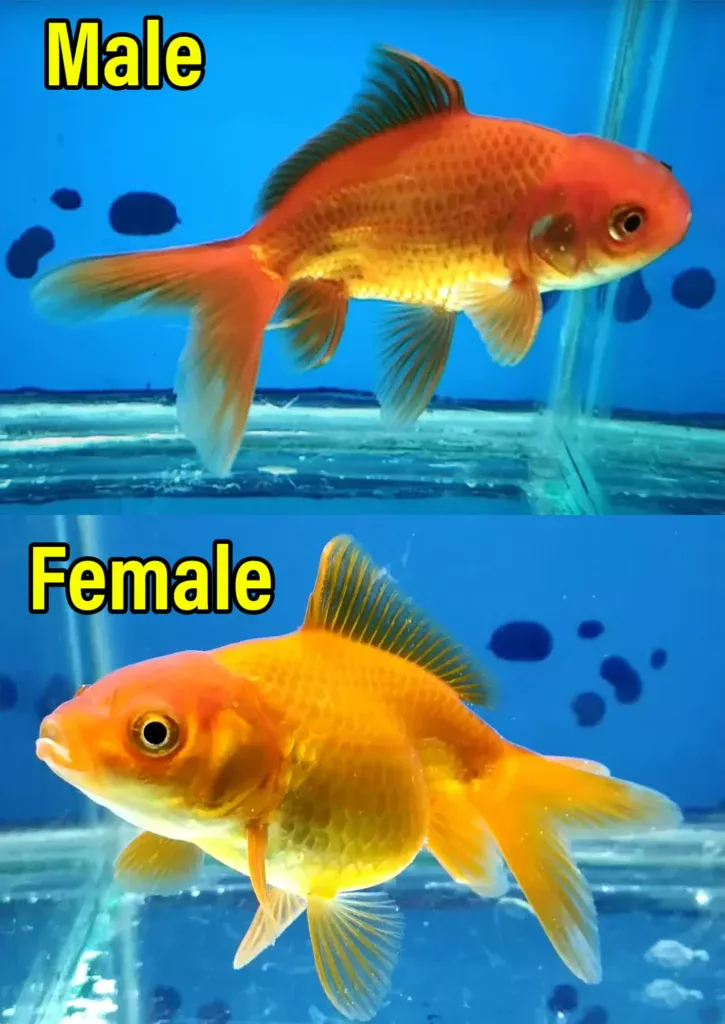
As we mentioned earlier, Fantails are a type of fancy goldfish and it can be difficult to determine the sex of a young fantail. As they grow, however, it becomes easier to tell male and female goldfish apart.
There are several differences between male and female fantails that make it easy to distinguish them once they mature. The most obvious difference is the shape of their tails. Male fantails have long, flowing tails while females have shorter ones that are rounder at the end.
The second most obvious difference between male and female fantails is their coloration. Male fantails have red on their heads and dorsal fins while females do not. The red on the head of males also extends down their body toward the tail fin; this does not happen in females.
Female fantails also tend to be smaller than males when fully grown; however, this is not always true as some males will actually be larger than females in some cases. In addition, female fantails also tend to have fewer spots on their bodies than males.
Fan Tailed Goldfish Potential Diseases
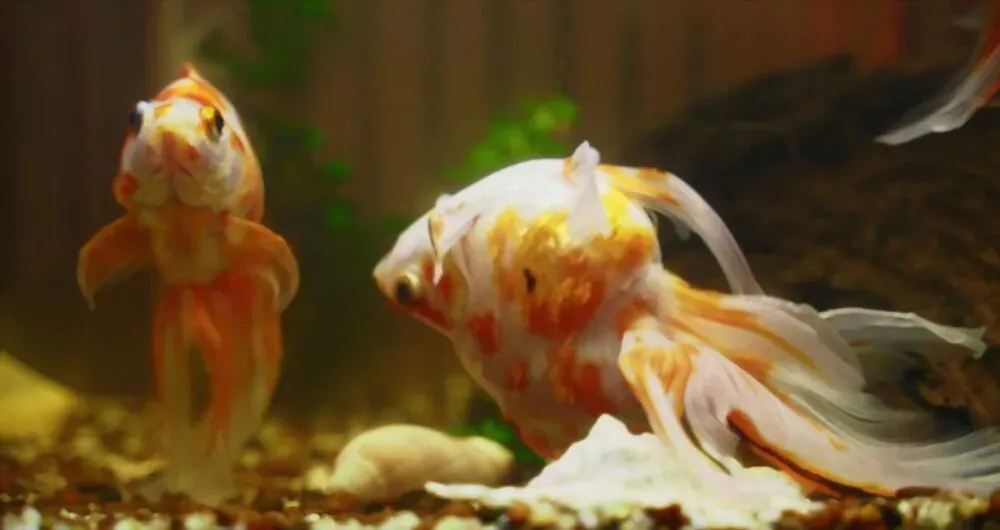
Fantail goldfish are prone to a variety of diseases, but most can be avoided with proper care. The following are some of the most common diseases found in fantail goldfish:
1- Swim Bladder Disease
Swim bladder disease is an infection that causes the fish’s swim bladder to become inflamed or infected. This can occur from poor water quality, injury or stress. Symptoms of this disease include gasping at the surface of the water and floating on its side. Swim bladder disease can be treated by adding aquarium salt to the water.
2- Fin Rot
Fin rot is another common disease that affects all types of fancy goldfish, including fantail goldfish. Fin rot is caused by stress or injury and may result in tissue damage on the fins if left untreated. Symptoms include soft tissue loss, redness, irritation, and inflammation along with cloudy eyes and lethargy if left untreated. Treatment involves improving water quality and adding aquarium salt to help with healing time; antibiotics may also be used if infection occurs.
3- Mouth Fungus
Mouth fungus looks like a white or brown spot on your goldfish’s skin. This fungus grows best in warm, moist environments and can be treated with antibiotics and salt baths. You can prevent mouth fungus by keeping your tank clean and making sure there is plenty of flow through your filter system.
4- Dropsy
Dropsy is a condition characterized by fluid accumulation in the body cavity or one or more body structures such as the eyes, skin, or abdomen. Symptoms include swelling at the base of the tail and scales sticking out from the body.
Benefits Of Owning A Fantail Goldfish?
There are many benefits of owning a fantail goldfish:
1- They’re Easy To Care For
The fantail goldfish is an excellent choice for beginners because it’s very easy to take care of them. All you have to do is keep their water clean and feed them regularly with flakes or pellets once a day or every other day (depending on the size of your tank).
2- They Have An Interesting Appearance
Fantails have a hard time swimming in open water, so they tend to stay near the surface or hide underneath objects. Their tails can also help them move by acting as rudders when they swim. This makes them great additions to fish tanks since they add color and movement to your tank!
3- They’re Low Maintenance
Because these fish are so easy to care for, most people don’t need any special equipment or knowledge before getting started with them. This makes them ideal pets for children who may be too young or inexperienced with other types of fish like guppies or goldfish.
4- Fantail Goldfish Are Easy To Find
Fantails are one of the most common types of goldfish on the market today. You can find them in almost any pet store or online shop that sells fish!
5- Fantail Goldfish Are Good For Kids
If you have a child who loves animals, then this might be a good choice for them because it’s easy for them to take care of and doesn’t require much space or money.
6- They’re Easy To Breed
Fantails are egg layers, so you won’t have to worry about taking care of fry once they hatch. Just make sure you keep their tank clean and free of ammonia buildup!
Downsides Of Owning A Fantail Goldfish?
Yes, there are a few downsides to owning a fantail goldfish:
1- They Are Prone To Diseases
The fantail goldfish is susceptible to a wide variety of diseases, including fin rot and fungus. This means that you will need to keep a close eye out for any signs of illness and treat them immediately. If you don’t, it could lead to your fish dying from the disease.
2- They Are Prone To Stress
The fantail goldfish is also prone to stress which can make them more susceptible to disease. They are particularly sensitive when they are younger and should be kept in tanks with plenty of hiding areas where they can hide when they feel threatened or stressed out. A male and female pair would also be more likely to get along better if they have their own space where they can retreat when it gets too much for them.
3- They Are Active Swimmers
The fantail goldfish is an active swimmer and requires a tank with plenty of swimming room. They will also need a place for them to rest and hide from time to time.
4- They Need Frequent Water Changes
The fantail goldfish is an active fish that needs frequent water changes. The tank should be cleaned at least once a week, and even more often if there are fish in the tank that produce a lot of waste.
5- They Can Be Aggressive
Fantails have been known to be aggressive towards other fish and even people who touch them too much or try to feed them by hand without using an automatic feeder system for pets like the Cat Mate C100 Automatic Food Dispenser for Cats & Dogs (Black).
Final Thoughts
Fantail Goldfish can be a wonderful addition to your home or backyard pond. They are beautiful, entertaining fish that are great at eating the algae in your pond. You should always keep an eye on them and make sure they are comfortable.
Hopefully, this guide has shed some light on the fantail goldfish and its needs. Please let us know your feedback in the comment section below.

